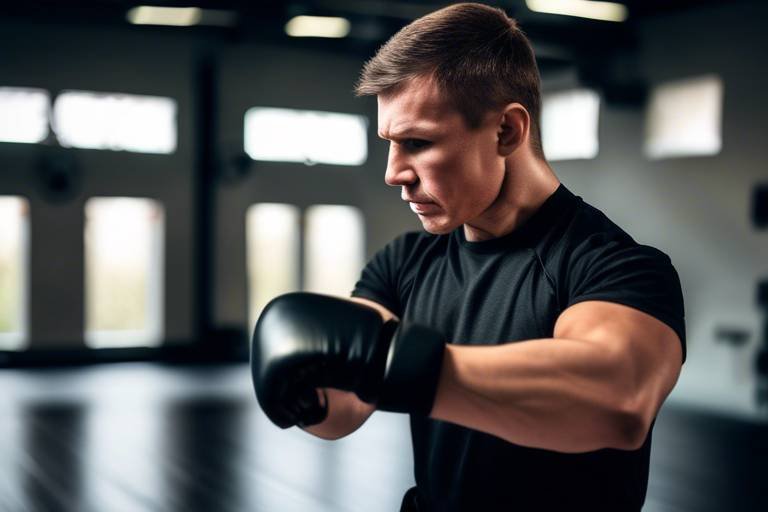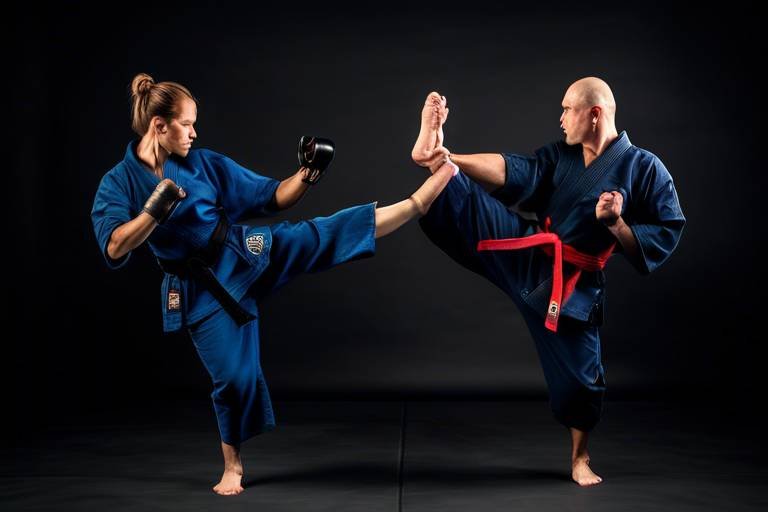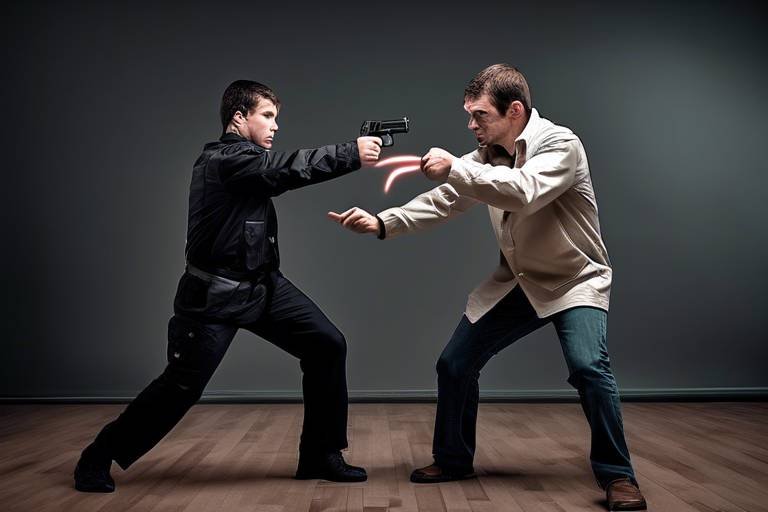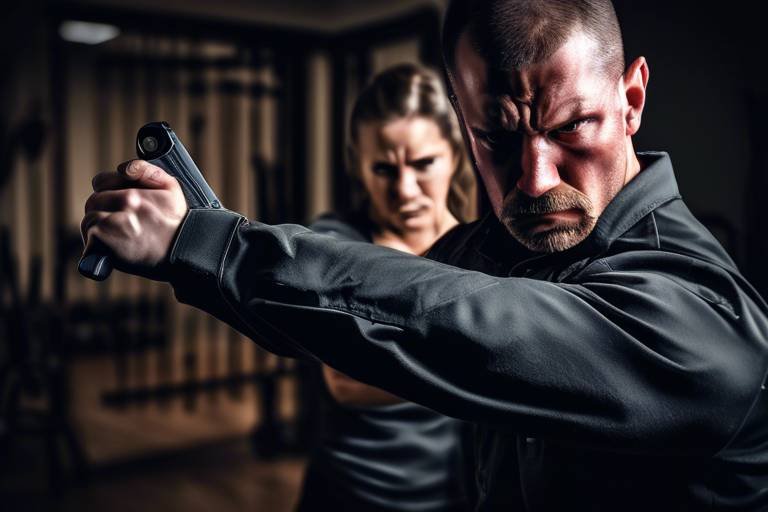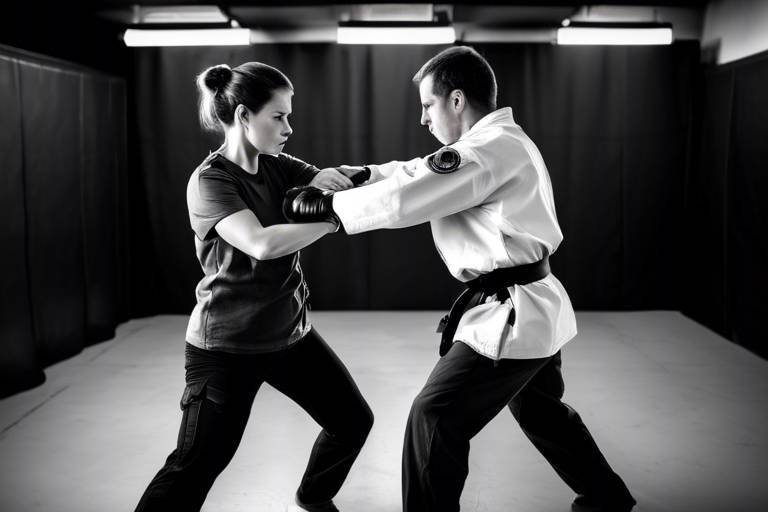Three Lesser-Known but Effective Self-Defense Techniques to Learn
In a world where personal safety is a growing concern, knowing how to defend oneself is more important than ever. While many people are familiar with traditional self-defense techniques, there are some lesser-known methods that can be incredibly effective in real-life situations. This article explores three unique self-defense techniques that are often overlooked yet highly effective. Understanding these methods can empower individuals to protect themselves in various situations, whether you're walking home at night or simply want to feel more secure in your daily life.
The palm strike is a powerful and straightforward self-defense move that anyone can learn. Imagine being in a situation where you need to act quickly. Instead of relying on a complicated punch, the palm strike allows you to deliver a strong blow to an attacker's face with minimal risk of injuring your own hand. The structure of your palm is designed to absorb impact, making it an ideal choice for self-defense. When executed properly, this technique can create an opportunity for you to escape. Just picture the moment your palm connects with your attacker's nose, sending them reeling back. This split-second decision could be the difference between safety and danger.
Knee strikes are another effective technique for close-range defense. This method utilizes your knee to target an attacker's groin, causing significant pain and disorientation. Think of it as your body's natural weapon—quick, powerful, and always ready to strike. When you're in a tight spot, a well-placed knee strike can incapacitate an attacker long enough for you to make your getaway. It’s important to understand the anatomy involved in this technique. By targeting vulnerable areas, you increase the likelihood of achieving the desired effect. The groin, for instance, is a sensitive area, and even a slight impact can lead to a dramatic response.
Knowledge of human anatomy enhances the effectiveness of knee strikes. When you know where to aim, you can maximize your chances of incapacitating your attacker. Here are some key areas to focus on:
- Groin: A classic target that can cause immediate pain.
- Solar Plexus: A strike here can knock the wind out of someone.
- Nose: An upward knee strike to the face can disorient an attacker.
By understanding these vulnerable spots, you can make your knee strikes not just effective, but devastatingly so.
Practicing knee strikes can significantly improve both accuracy and power. Regular training sessions help individuals become proficient, ensuring they can execute the technique effectively in high-stress situations. Think of it like learning to ride a bike; the more you practice, the more natural it becomes. You can start by practicing on a heavy bag or even with a partner, focusing on the technique rather than just the power. Over time, you'll build muscle memory that kicks in during a real-life scenario, making your responses instinctual and quick.
Being aware of your surroundings is crucial in self-defense. Recognizing potential threats allows individuals to prepare and react swiftly. Imagine walking down the street and noticing someone following you. Instead of panicking, your training kicks in, and you become aware of your options. This heightened awareness can make knee strikes more effective when needed. Always remember, the best defense is often avoiding confrontation altogether, but being prepared gives you the upper hand.
The elbow strike is a versatile and powerful technique suitable for various situations. It can be executed quickly and effectively, making it a valuable tool in close combat. Picture yourself in a crowded area, where you can’t afford to throw a wide punch without risking hitting someone else. An elbow strike allows you to deliver a powerful blow while keeping your movements compact. This technique is particularly effective when you're in close quarters, as it allows for a quick, explosive action that can catch an attacker off guard.
Integrating multiple self-defense techniques enhances overall effectiveness. Understanding how to combine moves like palm strikes, knee strikes, and elbow strikes can create a comprehensive self-defense strategy. Think of it as building a toolbox; each technique is a tool that serves a specific purpose. When you know how to use each one, you can adapt to any situation that arises. For example, you might use a palm strike to create space, followed by a knee strike to incapacitate your attacker, and finish with an elbow strike if they close in again.
Establishing a routine that incorporates these techniques can build muscle memory. Regular practice ensures that these skills become second nature, increasing confidence in self-defense scenarios. Consider setting aside time each week to practice these techniques, either alone or in a class. As you become more comfortable, you’ll find that your confidence grows, and the fear of confrontation diminishes.
Learning from experienced self-defense instructors can provide valuable insights. Professional training ensures that individuals understand the nuances of each technique, leading to more effective self-defense outcomes. It’s like having a coach in sports; they can help refine your techniques and provide feedback that you might not notice on your own. So, don’t hesitate to seek out classes or workshops in your area.
Q: Are these techniques suitable for everyone?
A: Yes! These techniques can be adapted for individuals of all ages and fitness levels. The key is to practice and find what works best for you.
Q: How long does it take to learn these techniques?
A: With regular practice, you can become proficient in these techniques within a few weeks. However, ongoing training is essential for maintaining your skills.
Q: Can I use these techniques in real-life situations?
A: While these techniques are effective, it's important to remember that self-defense should always be a last resort. The goal is to escape safely, not to engage in a fight.
Q: Where can I find professional training?
A: Look for local martial arts studios, community centers, or self-defense workshops in your area. Many offer classes specifically focused on personal safety and self-defense.

Technique 1: The Palm Strike
The palm strike is one of the most underrated yet powerful self-defense techniques you can learn. Picture this: you're in a situation where someone is trying to overpower you. Instead of panicking, you can use your palm as a weapon! This technique is not just effective; it's also incredibly simple to execute. The beauty of the palm strike lies in its straightforwardness—it allows you to deliver a strong blow to an attacker's face, specifically targeting the nose or chin, which can create an opportunity for you to escape.
When executed correctly, a palm strike can generate significant force. You might wonder, how does it compare to a punch? Well, punches can sometimes lead to injuries to your knuckles, especially if your aim is off. However, with a palm strike, you use the base of your palm, which is a much sturdier part of your hand. This means you can strike with confidence without the fear of hurting yourself. Imagine using your palm to push away a threat while simultaneously striking them—it's like a two-for-one deal!
To perform a palm strike, follow these simple steps:
- Stand with your feet shoulder-width apart to maintain balance.
- Raise your dominant hand, keeping your fingers slightly bent and your palm open.
- As you step forward, thrust your palm towards the attacker's face, aiming for the nose or chin.
- Follow through with the motion to maximize the impact.
It's essential to practice this technique regularly. Just like any skill, the more you practice, the better you'll get. You can even practice on a punching bag or with a partner to gauge your strength and accuracy. Remember, the goal is not just to strike but to create an opening for you to escape. In a self-defense scenario, your safety is the top priority.
In addition to physical practice, mental preparation is equally important. Visualize yourself in a threatening situation and imagine executing a palm strike successfully. This mental rehearsal can enhance your confidence and readiness when faced with real-life challenges. So, the next time you think about self-defense, don’t overlook the power of the palm strike—it might just be your best bet!

Technique 2: The Knee Strike
The knee strike is a self-defense technique that packs a punch—literally! This move is particularly effective in close-quarters situations where you might not have the space to execute a full kick or punch. Imagine finding yourself face-to-face with an aggressor; your options may seem limited, but with a well-timed knee strike, you can turn the tables in an instant. By driving your knee upward into the attacker's groin, you can deliver a devastating blow that not only causes intense pain but also disrupts their balance and focus, giving you a critical window to escape.
Now, let's break down why the knee strike is so effective. First, it’s all about targeting vulnerable areas of the body. The groin is one of the most sensitive parts of a human being, and a strike there can incapacitate an attacker long enough for you to make your getaway. Additionally, the knee strike can be executed quickly and with minimal preparation, making it a go-to move when you're caught off guard. Remember, in self-defense, speed and surprise are your best allies!
To truly master the knee strike, it’s essential to have a basic understanding of human anatomy. When you aim for the groin, you're not just hitting a random spot; you're targeting a highly sensitive area that is designed to protect itself. This means that even a moderate strike can yield significant results. Other effective targets include:
- The solar plexus: A strike here can knock the wind out of an attacker.
- The stomach: A knee to the stomach can cause disorientation.
- The thigh: Hitting the thigh can destabilize your opponent.
By knowing where to strike, you can maximize the effectiveness of your knee strike and increase the likelihood of escaping an attack.
Like any skill, mastering the knee strike requires practice. It’s not enough to know the technique; you need to be able to execute it accurately and with power. Regular training sessions can help you develop muscle memory, ensuring that when the moment arises, you can react instinctively. Consider practicing on a heavy bag or with a partner who can simulate an attack. The more you practice, the more confident you will become in your ability to defend yourself effectively.
Another crucial aspect of executing a knee strike is situational awareness. Being aware of your surroundings can help you identify potential threats before they escalate. For instance, if you notice someone approaching you in a suspicious manner, you can prepare yourself mentally and physically. This preparation can make a significant difference in how effectively you can utilize the knee strike. Remember, self-defense is not just about physical techniques; it’s about being alert and ready to respond to any situation.

Understanding the Anatomy
When it comes to self-defense, understanding the human body is not just an advantage; it’s a game-changer. Knowing where to strike can significantly increase the effectiveness of your techniques. For instance, targeting vulnerable areas such as the eyes, throat, and groin can incapacitate an attacker, giving you a crucial window to escape. Think of it like a chess game; if you know your opponent's weaknesses, you can make strategic moves that lead to victory.
The anatomy of an attacker can be broken down into several key areas that are particularly sensitive and can be used to your advantage:
- Eyes: A strike to the eyes can cause temporary blindness and disorientation.
- Throat: A swift jab to the throat can restrict breathing and create an opportunity to flee.
- Groin: This area is notoriously sensitive and can incapacitate an attacker with a well-placed knee strike.
- Solar Plexus: A hit here can knock the wind out of someone, giving you a moment to escape.
Understanding these target areas can make your knee strikes far more effective. For example, when you aim for the groin, you’re not just throwing a random strike; you’re executing a calculated move that can yield maximum impact. This knowledge not only boosts your confidence but also enhances your ability to defend yourself effectively.
Moreover, it's essential to practice these strikes regularly. Imagine a musician who practices daily; their skills become second nature, allowing them to perform with confidence. Similarly, when you train to strike these vulnerable areas, you develop muscle memory that can be a lifesaver in high-pressure situations. Regular training sessions can help you refine your technique, ensuring that when the moment arrives, you can react instinctively.
In summary, understanding the anatomy of your attacker is a crucial part of self-defense training. By focusing on vulnerable areas and practicing your strikes, you equip yourself with the tools needed to protect yourself effectively. Remember, knowledge is power, and in the world of self-defense, it can be the difference between safety and danger.

Training for Accuracy
This article explores three unique self-defense techniques that are often overlooked yet highly effective. Understanding these methods can empower individuals to protect themselves in various situations.
The palm strike is a powerful and straightforward self-defense move. It allows individuals to deliver a strong blow to an attacker's face, creating an opportunity to escape.
Knee strikes are effective for close-range defense. This technique utilizes the knee to target an attacker's groin, causing significant pain and disorientation, allowing for a quick getaway.
Knowledge of human anatomy enhances the effectiveness of knee strikes. Targeting vulnerable areas increases the likelihood of incapacitating an attacker, making this technique a valuable addition to self-defense skills.
To truly master the knee strike, is essential. Think of it like honing a musician's skills—the more you practice, the better you become. Regular drills can help you develop precision and power, which are crucial when you find yourself in a high-stress situation. Here are a few key points to consider:
- Repetition is Key: Just like learning to ride a bike, the more you practice your knee strikes, the more instinctive they become. Start slowly, focusing on form and technique, and gradually increase your speed and intensity.
- Use a Training Partner: Practicing with a partner can simulate real-life scenarios. This allows you to gauge distance and adjust your strikes accordingly. It’s like playing catch; you need to know where to throw the ball to make a successful play.
- Incorporate Target Training: Use bags or pads to practice your strikes. This not only improves your accuracy but also builds strength in your legs. Think of it as hitting the gym for your self-defense skills.
Additionally, consider recording your training sessions. Watching yourself can provide insight into your form and technique, much like reviewing game footage can help an athlete improve. Aim to create a training schedule that includes specific drills focusing on the knee strike, ensuring you’re consistently working on your accuracy.
Being aware of one's surroundings is crucial in self-defense. Recognizing potential threats allows individuals to prepare and react swiftly, making knee strikes more effective when needed.
The elbow strike is a versatile and powerful technique suitable for various situations. It can be executed quickly and effectively, making it a valuable tool in close combat.
Integrating multiple self-defense techniques enhances overall effectiveness. Understanding how to combine moves like palm strikes, knee strikes, and elbow strikes can create a comprehensive self-defense strategy.
Establishing a routine that incorporates these techniques can build muscle memory. Regular practice ensures that these skills become second nature, increasing confidence in self-defense scenarios.
Learning from experienced self-defense instructors can provide valuable insights. Professional training ensures that individuals understand the nuances of each technique, leading to more effective self-defense outcomes.
Q1: Can anyone learn these self-defense techniques?
A1: Absolutely! These techniques are designed to be simple and effective, making them accessible to anyone willing to learn and practice.
Q2: How often should I practice these techniques?
A2: Regular practice is essential. Aim for at least a few sessions each week to build muscle memory and confidence.
Q3: Should I seek professional training?
A3: Yes, professional guidance can provide you with personalized feedback and help you refine your techniques, ensuring you are prepared for real-life situations.

Situational Awareness
Situational awareness is like having a superpower in the chaotic world we live in. Imagine walking down a busy street, and instead of being glued to your phone, you’re fully aware of your surroundings. This heightened state of awareness allows you to notice things that others might overlook, such as a suspicious individual lingering too long or a group of people behaving oddly. By sharpening your situational awareness, you essentially equip yourself with the ability to assess potential threats before they escalate.
To enhance your situational awareness, consider adopting a few simple yet effective practices. First, regularly scan your environment. This doesn’t mean you need to look like a paranoid person constantly checking over your shoulder, but rather, make it a habit to take in your surroundings. Observe the people around you, the layout of the area, and any exits that could be useful in an emergency. You can think of it as a mental map—knowing where you are and what’s around you can make a world of difference.
Another vital aspect is to trust your instincts. If something feels off, it probably is. Our gut feelings are often based on subtle cues we might not consciously recognize. For instance, if you notice someone following you or if a stranger approaches you with an unusual demeanor, don’t brush it off. Instead, take it seriously and prepare to react. Remember, being proactive rather than reactive can be the difference between a safe exit and a dangerous encounter.
Moreover, consider practicing mindfulness. Engaging in mindfulness exercises can help you stay present and focused, making it easier to pick up on the nuances of your environment. This could include simple breathing exercises or even meditation. The more you train your mind to be aware, the sharper your situational awareness will become.
Lastly, it’s essential to engage with your environment actively. This could mean participating in community events, joining local self-defense classes, or simply having conversations with those around you. Building a sense of community can not only enhance your awareness but also create a network of support should you ever find yourself in a tricky situation.
In summary, situational awareness is an invaluable skill that can significantly improve your self-defense capabilities. By being aware of your surroundings, trusting your instincts, practicing mindfulness, and engaging with your community, you can create a safer environment for yourself and others. So, the next time you step out, remember: your awareness is your first line of defense.
- What is situational awareness?
Situational awareness is the ability to perceive and understand your environment, allowing you to identify potential threats and respond appropriately. - How can I improve my situational awareness?
You can improve your situational awareness by regularly scanning your environment, trusting your instincts, practicing mindfulness, and actively engaging with your community. - Why is situational awareness important in self-defense?
Situational awareness is crucial in self-defense as it helps you recognize potential dangers before they escalate, giving you the opportunity to react and protect yourself. - Can I practice situational awareness in everyday life?
Absolutely! You can practice situational awareness in everyday situations, such as walking in your neighborhood, shopping, or even while commuting.

Technique 3: The Elbow Strike
The elbow strike is a surprisingly effective technique that many people overlook in self-defense scenarios. It’s not just about brute force; this move combines speed, precision, and power, making it a formidable option when you find yourself in a tight spot. Imagine being in a crowded space where an attacker is too close for comfort. The elbow strike allows you to use your body’s natural mechanics to deliver a powerful blow without needing much room to maneuver.
What makes the elbow strike so effective? For starters, it's a short-range weapon that can be executed quickly. By simply pivoting your body and driving your elbow into your attacker's face, ribs, or other vulnerable areas, you can create a moment of shock and disorientation. This is crucial because it gives you a chance to escape. In fact, the elbow strike is often used in various martial arts because of its effectiveness in close combat situations.
Here are a few key points to consider when practicing the elbow strike:
- Target Areas: Aim for sensitive spots such as the jaw, temple, or solar plexus. Targeting these areas can increase the likelihood of incapacitating your attacker.
- Body Mechanics: Use your entire body to generate power. It’s not just your arm doing the work; engage your hips and shoulders to add force to your strike.
- Practice Makes Perfect: Regular practice helps improve your speed and accuracy. The more you train, the more instinctive the move becomes in high-pressure situations.
Incorporating the elbow strike into your self-defense arsenal can be a game changer. It’s versatile, effective, and can be used in a variety of situations, whether you’re standing or even on the ground. Just like a well-practiced musician knows their instrument inside and out, mastering the elbow strike can give you the confidence to handle unexpected confrontations.
Moreover, the beauty of the elbow strike lies in its simplicity. You don’t need special equipment or extensive training to execute it effectively. A few focused training sessions can help you understand the nuances of the technique, allowing you to use it instinctively when the need arises. When combined with other techniques, such as the palm strike or knee strike, the elbow strike becomes even more powerful, creating a comprehensive self-defense strategy that can adapt to various threats.
In conclusion, the elbow strike is a potent self-defense technique that deserves a place in everyone’s skill set. Whether you're a seasoned martial artist or just starting your self-defense journey, learning how to effectively use your elbows can enhance your ability to protect yourself. Remember, the key is to stay calm, focused, and ready to respond when faced with danger.

Combining Techniques for Maximum Effectiveness
When it comes to self-defense, relying on a single technique can leave you vulnerable. Instead, combining techniques can create a powerful arsenal that enhances your ability to protect yourself in various situations. Imagine being a chef who knows how to make a delicious dish; it’s not just about one ingredient, but how you blend them together to create something extraordinary. Similarly, integrating moves like the palm strike, knee strike, and elbow strike can significantly increase your effectiveness in a self-defense scenario.
Think of it this way: if you throw a palm strike to an attacker's face, you might stun them momentarily. But what if you follow that up with a knee strike targeting their groin? This combination not only maximizes the impact but also creates a window for escape. The sequence of techniques can be as fluid as a dance, where each move complements the other, creating a rhythm that enhances your overall performance.
To effectively combine techniques, it's essential to understand the context and the environment in which you might need to use them. For example, if you find yourself in a crowded area, executing a knee strike might be challenging due to proximity. In such cases, a palm strike followed by an elbow strike could be more effective. The key is to remain adaptable and aware of your surroundings.
Additionally, practicing these combinations can help you develop muscle memory. Just like athletes train tirelessly to perfect their movements, you should incorporate these techniques into your regular training sessions. Here’s a simple routine to help you get started:
| Technique | Follow-up Move | Purpose |
|---|---|---|
| Palm Strike | Knee Strike | Stun and incapacitate |
| Knee Strike | Elbow Strike | Target vulnerable areas |
| Elbow Strike | Escape | Clear path for exit |
Incorporating these combinations into your training will not only build confidence but also prepare you for real-life situations where quick thinking and adaptability are crucial. You’ll find that as you practice, the sequences become more intuitive, allowing you to react swiftly under pressure.
Lastly, don't underestimate the power of mental preparation. Visualization can be a powerful tool. Imagine yourself in a scenario where you need to defend yourself. Picture the sequence of moves in your mind, and how you would execute them. This mental rehearsal can be just as important as physical training, ensuring you are ready to combine techniques effectively when the time comes.
- What if I can't remember the techniques during a stressful situation?
It's common to forget techniques under stress. Regular practice and mental visualization can help reinforce your memory. - How often should I practice these techniques?
Aim for at least two to three times a week to build muscle memory and confidence. - Can these techniques be used by anyone?
Yes! These techniques can be adapted to suit individuals of various ages and fitness levels.

Creating a Self-Defense Routine
Establishing a self-defense routine is like building a muscle; the more you work on it, the stronger it becomes. Just as athletes train regularly to enhance their performance, incorporating self-defense techniques into your daily life can significantly boost your confidence and readiness. But how do you create an effective routine? It starts with consistency and commitment.
First, set aside dedicated time each week for practice. Think of it as an appointment with yourself that you cannot miss. Whether it's 30 minutes a day or a couple of hours a week, make it a priority. In this time, focus on the three techniques we've discussed: the palm strike, knee strike, and elbow strike. You can structure your routine like this:
| Day | Technique Focus | Duration |
|---|---|---|
| Monday | Palm Strike Practice | 30 minutes |
| Wednesday | Knee Strike Drills | 30 minutes |
| Friday | Elbow Strike Techniques | 30 minutes |
| Saturday | Combination Practice | 1 hour |
By focusing on one technique each day, you can dive deeper into perfecting your form and understanding the mechanics behind each move. On Saturdays, combine all three techniques to simulate a real-life scenario. This not only enhances your skills but also builds your confidence in executing them under pressure.
Moreover, consider incorporating situational awareness drills into your routine. Awareness is your first line of defense. Spend a few minutes each session practicing how to identify potential threats in your environment. This could involve walking through a park and noting exits, or observing how people around you interact. The more you practice being aware, the more instinctive it will become.
Don't forget to track your progress. Keep a journal of your training sessions, noting what worked well and what needs improvement. This reflection can be incredibly empowering, as it allows you to see how far you've come. It can also help you identify any weaknesses in your technique that you might want to focus on in future sessions.
Lastly, remember that while self-defense techniques are crucial, the mental aspect is just as important. Visualize yourself in different scenarios and how you would react. This mental rehearsal can be just as effective as physical practice, preparing you for real-life situations where you need to act quickly and decisively.
In summary, creating a self-defense routine requires dedication, consistency, and a well-structured approach. By focusing on specific techniques, incorporating situational awareness, tracking your progress, and engaging in mental rehearsal, you’ll not only enhance your skills but also build the confidence necessary to protect yourself when it truly matters.
- How often should I practice self-defense techniques? Regular practice is key; aim for at least two to three times a week.
- Can I practice self-defense techniques alone? Yes, many techniques can be practiced solo, but working with a partner can provide valuable feedback.
- What if I don't have access to a gym or training facility? You can practice self-defense techniques at home or in a safe outdoor area.
- Is it necessary to take a self-defense class? While not mandatory, professional instruction can greatly enhance your understanding and execution of techniques.

Seeking Professional Guidance
When it comes to mastering self-defense techniques, seeking professional guidance can be a game-changer. Imagine trying to learn how to ride a bike without ever having someone show you the ropes. It’s tough, right? Similarly, self-defense is a skill that benefits immensely from the expertise of trained instructors. They can provide you with personalized feedback, correct your form, and teach you the subtleties of each technique that you might miss when practicing alone.
Professional instructors bring a wealth of experience and knowledge to the table. They can help you understand the psychology of self-defense—what to expect in a confrontation and how to react. This kind of insight is invaluable, especially when you consider the adrenaline rush and confusion that can accompany a real-life threat. Furthermore, instructors often create a safe environment where you can practice these techniques without the fear of injury, allowing you to build confidence and competence.
In addition to hands-on training, many self-defense schools offer a variety of resources, such as video tutorials, workshops, and seminars. These resources can supplement your learning and provide you with new perspectives on self-defense strategies. For example, attending a workshop focused on situational awareness can enhance your ability to assess threats and react appropriately, making your self-defense skills even more effective.
Moreover, training with others can foster a sense of community and support. You’ll find that many students share similar goals and fears, which can create a motivating atmosphere. Practicing with partners allows you to simulate real-life scenarios, enhancing your ability to apply techniques under pressure. It's like having a training buddy in the gym, pushing you to lift that extra weight!
Ultimately, investing in professional self-defense training is not just about learning techniques; it's about empowering yourself to feel safe and confident in any situation. So, if you’re serious about your self-defense journey, consider enrolling in a class or workshop. You’ll be amazed at how much you can grow with the right guidance!
- What should I look for in a self-defense instructor? Look for someone with experience, good communication skills, and a supportive teaching style. Check their credentials and read reviews from past students.
- How often should I practice self-defense techniques? Consistency is key! Aim for at least once a week, but more frequent practice will help reinforce your skills and build muscle memory.
- Can self-defense training help with confidence? Absolutely! Learning self-defense techniques can significantly boost your confidence, making you feel more secure in your ability to handle potential threats.
Frequently Asked Questions
- What is a palm strike and how effective is it?
The palm strike is a self-defense technique that involves using the heel of your palm to strike an attacker's face or nose. It's surprisingly powerful and can create enough force to disorient an attacker, giving you a chance to escape. This technique is straightforward and can be executed quickly, making it an excellent first line of defense.
- How do knee strikes work in self-defense?
Knee strikes are designed for close-range encounters. By driving your knee into an attacker's groin, you can cause significant pain and disorientation. This technique is effective because it targets a vulnerable area of the body, increasing the chances of incapacitating the attacker long enough for you to flee.
- Is it necessary to understand anatomy for effective self-defense?
Absolutely! Understanding human anatomy can greatly enhance the effectiveness of techniques like knee strikes. Knowing where to strike for maximum impact can make a huge difference in a self-defense situation. Targeting vulnerable areas increases your chances of successfully defending yourself.
- How can I improve my accuracy with knee strikes?
Regular training is key to improving accuracy and power in knee strikes. Practicing these techniques consistently helps build muscle memory, allowing you to execute them effectively, even in high-stress situations. Consider setting up a training routine to refine your skills.
- What role does situational awareness play in self-defense?
Situational awareness is crucial in self-defense. By being aware of your surroundings, you can recognize potential threats and react swiftly. This awareness allows you to prepare and choose the most effective technique, whether it's a palm strike, knee strike, or elbow strike.
- Can elbow strikes be used in various situations?
Yes! Elbow strikes are highly versatile and can be used effectively in close combat. They can be executed quickly, making them a valuable addition to your self-defense arsenal. Whether you're defending against a grab or a punch, elbow strikes can provide a powerful counter.
- How can I combine different self-defense techniques?
Integrating multiple techniques, like palm strikes, knee strikes, and elbow strikes, can enhance your overall self-defense strategy. By understanding how to combine these moves, you can create a fluid response to various attack scenarios, increasing your chances of successfully defending yourself.
- Is professional training recommended for learning self-defense?
Yes, seeking guidance from experienced self-defense instructors is highly recommended. Professional training can provide valuable insights into the nuances of each technique, ensuring that you learn them correctly. This guidance can lead to more effective self-defense outcomes and increased confidence in your abilities.





